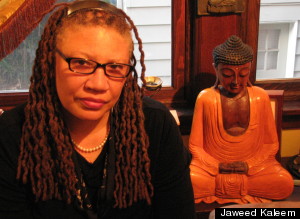In a Huffington Post article published yesterday, religion reporter Jaweed Kaleem offers an insightful look into POC sitting groups in the American dharma scene. The article, “Buddhist ‘People Of Color Sanghas,’ Diversity Efforts Address Conflicts About Race Among Meditators,” examines the need for minority sanghas alongside the seemingly “un-Buddhist” intention to form exclusive communities and courses for people of color. Kaleem writes,
Here in Seattle, one of the least racially diverse cities with one of the largest Buddhist communities in the country, a controversial movement in American Buddhism is forming. A handful of exclusive ‘people of color’ Buddhist groups have started to meet each week, far away from the long-established—and almost entirely white—major Buddhist meditation centers that have dominated the Pacific Northwest’s well-known Buddhist scenes. Many members, who have until now shied away from meditation and Buddhism, say practicing away from the white majority, among whom they say they don’t feel welcome, has spiritually empowered them—and they wouldn’t have it any other way.
Anytime the issue of race in American Buddhism comes up (let’s face it: anytime the issue of race in general comes up), the resulting conversation is bound to ripple with tension, so we applaud Kaleen for taking on such a contentious topic while simultaneously drawing awareness to an important issue. Already, the article has garnered almost 2,000 comments, with many of the commenters taking offense at the purported “reverse racism” in the piece. A lot of attention has focused around the rules of one POC sitting group in Seattle: “Men could come, but the group happened to be women. No whites were allowed.”
 The need for POC sitting groups, retreats, and sanghas is often misunderstood; the response to such demand is prone to become an insistence that Buddhism goes beyond race, thus trivializing many POC’s suffering and personal experience with institutionalized racism in the United States. This article is an excellent reminder that we should not be using Buddhism as an excuse to hide from the painful realities of race relations in our nation. It also, we hope, explains why minority sitting groups are necessary for many to enter the dharma. As Tuere Sala, a black Buddhist teacher, recollects in the article of her first experience at the Seattle Insight Meditation Society, “We walked into this room and there were 60 white people. No black people. No people of color. I did not want to stay.” And who can blame her? I’ve met with enough sanghas whose members were all at least a decade older than me to know that even a subtle feeling of I don’t fit in here or This isn’t for people like me can quickly extinguish the enthusiasm of someone who is interested in Buddhism and beginning to cautiously explore it.
The need for POC sitting groups, retreats, and sanghas is often misunderstood; the response to such demand is prone to become an insistence that Buddhism goes beyond race, thus trivializing many POC’s suffering and personal experience with institutionalized racism in the United States. This article is an excellent reminder that we should not be using Buddhism as an excuse to hide from the painful realities of race relations in our nation. It also, we hope, explains why minority sitting groups are necessary for many to enter the dharma. As Tuere Sala, a black Buddhist teacher, recollects in the article of her first experience at the Seattle Insight Meditation Society, “We walked into this room and there were 60 white people. No black people. No people of color. I did not want to stay.” And who can blame her? I’ve met with enough sanghas whose members were all at least a decade older than me to know that even a subtle feeling of I don’t fit in here or This isn’t for people like me can quickly extinguish the enthusiasm of someone who is interested in Buddhism and beginning to cautiously explore it.
We’re happy to see these issues of race being discussed in mainstream media, so our hats to you, Kaleem. That being said, we were disappointed to see the writer himself fall to the temptation of stereotyping—seemingly the result of poor research. He writes midway through the piece,
There are about two million Buddhists in the U.S., and each usually falls into one of two camps. On one side are Asian-American Buddhists, who have been in the U.S. since the mid-19th century and whose numbers blossomed after 1965, when immigration quotas were lifted. One in seven Asians in the U.S. is Buddhist. Most Asian-American Buddhists practice at home, and small numbers also observe their faith at Buddhist temples, the kind known for their ornate architecture and large Buddha statues. Studies have shown that most Asian-American Buddhists don’t meditate. Instead, they practice the faith by venerating ancestors, spiritually observing holidays such as Lunar New Year and practicing yoga, and they believe in nirvana and reincarnation.
The second and more dominant camp of Buddhism is made up largely of white converts, who count for more than half of U.S. Buddhists; less than one in three are Asian.
Unfortunately, the numbers here are way off, as a new Pew study has shown that Asian American Buddhists actually make up two-thirds of the overall American Buddhist population. Arunlikhati, our friend The Angry Asian Buddhist, explains over at his blog why getting these numbers right is important:
Through his interpretation of the survey data, Kaleem perpetuates the stereotype that Asian Americans Buddhists basically don’t meditate much and instead preoccupy themselves with ritual and superstition. A closer look at the data, however, suggests that Asian American Buddhists simply participate less in some of the key rituals and beliefs which strongly characterize non-Asian American Buddhists.
We strongly encourage you to check out both Kaleem’s article and Arunlikhati’s response.
UPDATE: Jaweed Kaleem has updated his story to fix the inaccuracies originally contained within it.
Thank you for subscribing to Tricycle! As a nonprofit, we depend on readers like you to keep Buddhist teachings and practices widely available.